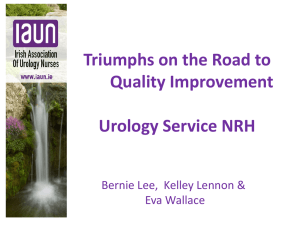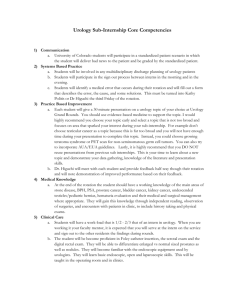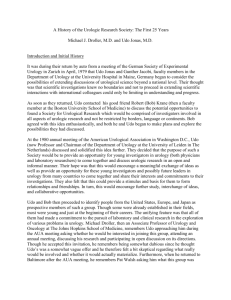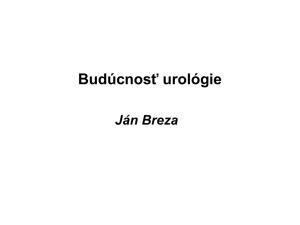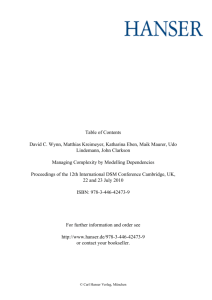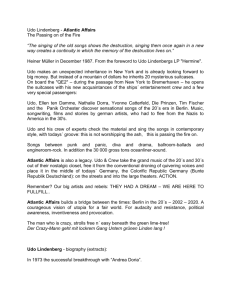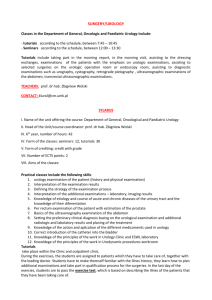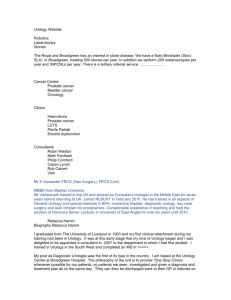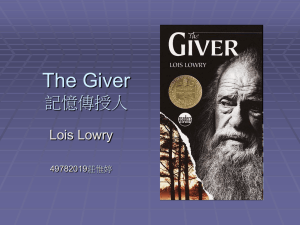How it began - Urological Research Society
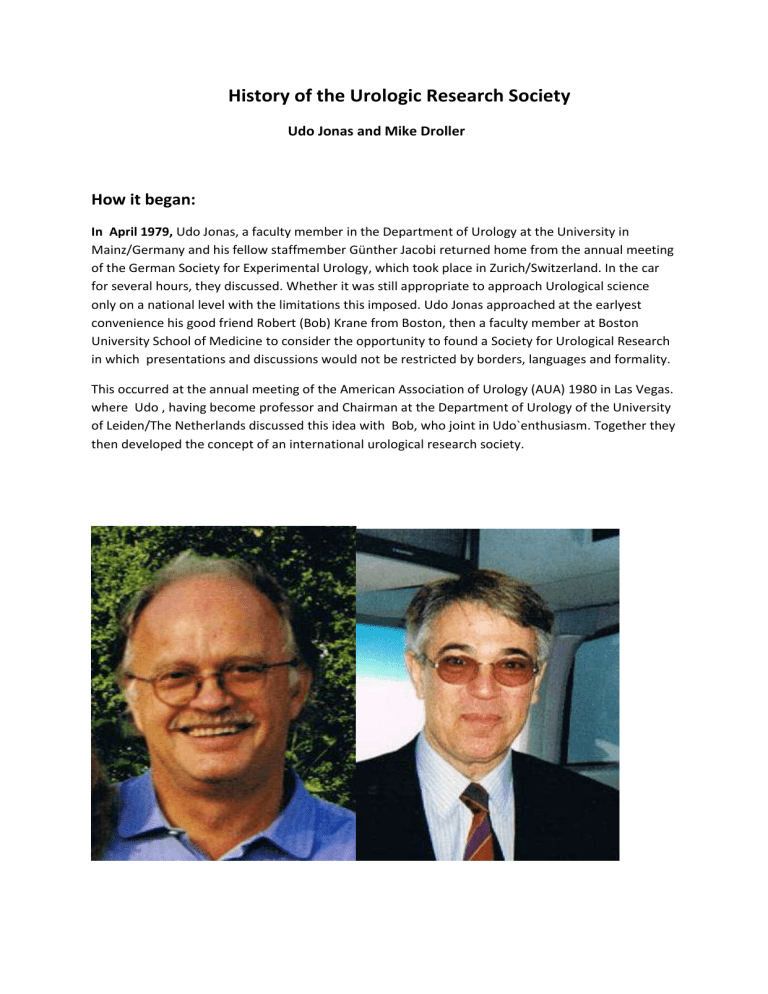
History of the Urologic Research Society
Udo Jonas and Mike Droller
How it began:
In April 1979, Udo Jonas, a faculty member in the Department of Urology at the University in
Mainz/Germany and his fellow staffmember Günther Jacobi returned home from the annual meeting of the German Society for Experimental Urology, which took place in Zurich/Switzerland. In the car for several hours, they discussed. Whether it was still appropriate to approach Urological science only on a national level with the limitations this imposed. Udo Jonas approached at the earlyest convenience his good friend Robert (Bob) Krane from Boston, then a faculty member at Boston
University School of Medicine to consider the opportunity to found a Society for Urological Research in which presentations and discussions would not be restricted by borders, languages and formality.
This occurred at the annual meeting of the American Association of Urology (AUA) 1980 in Las Vegas. where Udo , having become professor and Chairman at the Department of Urology of the University of Leiden/The Netherlands discussed this idea with Bob, who joint in Udo`enthusiasm. Together they then developed the concept of an international urological research society.
URS meeting, Bordeaux 1999
Their idea was to provide an opportunity for young investigators in urology (both physicians and laboratory researchers) to come together at annual meetings to discuss their research data in an open and informal manner. The hope was, that this would encourage an exchange of ideas as well as an opportunity for young people from various countries to share their interest in the various areas of urology using these meetings not only to discuss science but also to form relation and friendshs. This would then stimulate further study, exchange of ideas, and collaborative opportunities.
During this AUA meeting, a core group of investigators from the United States, Europe, and Japan as prospective members of such a group were identified by Udo and Bob. Though some were already established in their fields, most were young and just at the beginning of their careers. All of them had made a commitment to the pursuit of laboratory and clinical research in the exploration of various problems in urology. One of the first, who was approached by Udo and Bob was Michael Droller, at then a faculty member in the Department of Urology and Oncology at the Johns Hopkins Medical
Center in Baltimore. Though he liked this idea and accepted his invitation, he was a bit sceptical regarding what really would be involved and whether it would actually materialize. When he returned to Baltimore after the AUA meeting, Pat Walsh asked him what this group was about (he had also been approached) and expressed his doubts about what would actually come of it.
However, the overall response of those, who were approached was very positive. The objectives of the society members were to be actively engaged in research, reflecting a broad geographic distribution, representing the various subspecialty areas in urology . They should be in a formative phase in their careers and have already been recognized through their work and publications as being productive and potential leaders in their areas of interest. Together, this would make this an unique society from its very beginning. No other society fulfilled all of this: most research societies were comprised of individuals who had already become well-established and had already been identified as leaders in urology. None represented a broad geographic distribution. And, though some attempted to encourage open exchange of information through informal discussion of research presentations at their meetings, none were sufficiently informal in their structure and through their membership to truly foster such open discussion or to encourage constructive critiques of the work that was being presented. Within this context, 33 individuals were asked to join in as founding members of what was to become the Urologic Research Society:
Founding member of the Urological Research Society:
Rolf Ackermann, M.D., University of Würzburg, Würzburg, Germany
George Bartsch, M.D., Urolgogische Universitätsklinik, Innsbruck, Austria
William J. Catalona, M.D., Washington University, St. Louis, Missouri, USA
Geoffrey D. Chisholm, M.D., University of Edinburgh, Edinburgh, Scotland
Donald S. Coffery, Ph.D., Johns Hopkins School of Medicine, Baltimore, Maryland
B.L.R.A. Coolsaet, M.D., University of Utrecht, Utrecht, The Netherlands
Michael J. Droller, M.D., Johns Hopkins School of Medicine, Baltimore, Maryland
William R. Fair, M.D., Washington University, St.Louis, Missouri, USA
John M. Fitzpatrick, M.D., University College, Dublin, Ireland
Reza Ghanadian, M.D., Clinical Research Laboratory, London, England
Donald P. Griffith, M.D., Baylor Univestiy School of Medicine, Houston, Texas
Richard Hautmann, M.D., University of Aachen, Aachen, Germany
Yoshiko Hirao, M.D., University of Nara, Nara, Japan
Udo Jonas, M.D., University of Leiden, Leiden, The Netherlands
Tadeo Kakizoe, M.D., University of Tokyo, Tokyo, Japan
Daniel P. deKlerk, M.D., University of Cape Town, Cape Town, South Africa
Robert J. Krane, M.D., Boston University School of Medicine, Boston, Massachusetts
Paul H. Lange, M.D., University of Minnesota, Minneapolis, Minnesota
Larry I. Lipshultz, M.D., Baylor University School of Medicine, Houston, Texas
Michael Marberger, M.D., Universitätsklinik, Vienna, Austria
Carl A. Olsson, M.D. Columbia College of Physicians and Surgeons, New York, NY
David F. Paulsen, M.D., Duke University School of Medicine, Durham, North Carolina
Philip A. Ransley, M.D., University College London, London, England
Martin I. Resnick, M.D., Case-Western Reserve University, Cleveland, Ohio
Richard Schmidt, M.D., University of California, San Francisco, California
Fritz H. Schroeder, M.D., University of Rotterdam, Rotterdam, The Netherlands
Claude A. Schulman, M.D., Hopital Erasme, Brussels, Belgiu
Theo Senge, M.D., Herne, Ruhruniversität Bochum,German
Mark S. Soloway, M.D., University of Tennessee, Memphis, Tennesse
Emil A. Tanagho, M.D., University of California, San Francisco, California
E. Darracott Vaughan, M.D., New York Hospital, New York, New Yor
Hermann J. de Voogt, M.D., University of Amsterdam, Amsterdam, The Netherlands
Alan J. Wein, M.D., University of Pennsylvania, Philadelphia, Pennsylvania
The first two meetings of this new society were held in Leiden, The Netherlands and Boston,
Massachusetts, hosted by Udo Jonas and Bob Krane, respectively. 15 members participated on the first meeting, held on August 29th 1981.
The first group picture taken at an URS meeting Leiden, 1981
Standing from left to right: Rheza Ghanadian, John Fitzpatrik, Michael Marberger, Hermann de Vogt, Rolf Ackermann, Bill
Fair, Don Coffey, Bob Krane, Mark Soloway, Richard Hautmann, Jaap Zwartendijk
1 st row:, from left to right: Günther Jacobi, Udo Jonas, Rick Schmidt, Georg Bartsch
These founding members provided an excellent stimulus and the beginning of an enthusiasm for the opportunities of meeting new colleagues, discuss research projects, and develop social interactions across international borders.
Quickly it became evident, that the group needed a logo. Udo, who acted for the first 15 years as URS secretary asked a friend to design something, which could represent Urology (urine, and bladder).
The first draft was circulated among the members for comments and suggestions:
The most original comment came from Don Coffey:
who integrated urological specificities, added the financial aspect but finally described the aim of the society as:
“yoU aRe uS”
By this, the final logo for the society’s stationery and the official URS tie were established.
Inaugural meeting, Leiden, 1981: program and list of participants:
With the second meeting, held in Boston immediately following the AUA meeting in Kansas City
1982, a momentum began to develop for individuals to host these meetings and to have the format of informal and provocative discussions that either were not possible or simply did not take place at other meetings.
Following the successful launch of this exciting new research society, it seemed only logical that this group should have an “official” journal, the “World Journal of Urology “(WJUrol), which would be published by Springer Verlag. The first issue appeared in 1983 and today remains a flourishing publication with recent mpact factor of 2,41. The first editor’s in chief were Udo Jonas and Bob
Krane.
The history of the URS has been closely attached to 2 urologists and close friends: Udo Jonas and Bob
Krane.
Bob left us in 2011 already, much too early, still we will remember him and his achievement. We lost a charismatic and highly competent urologist, I lost a very good friend!
